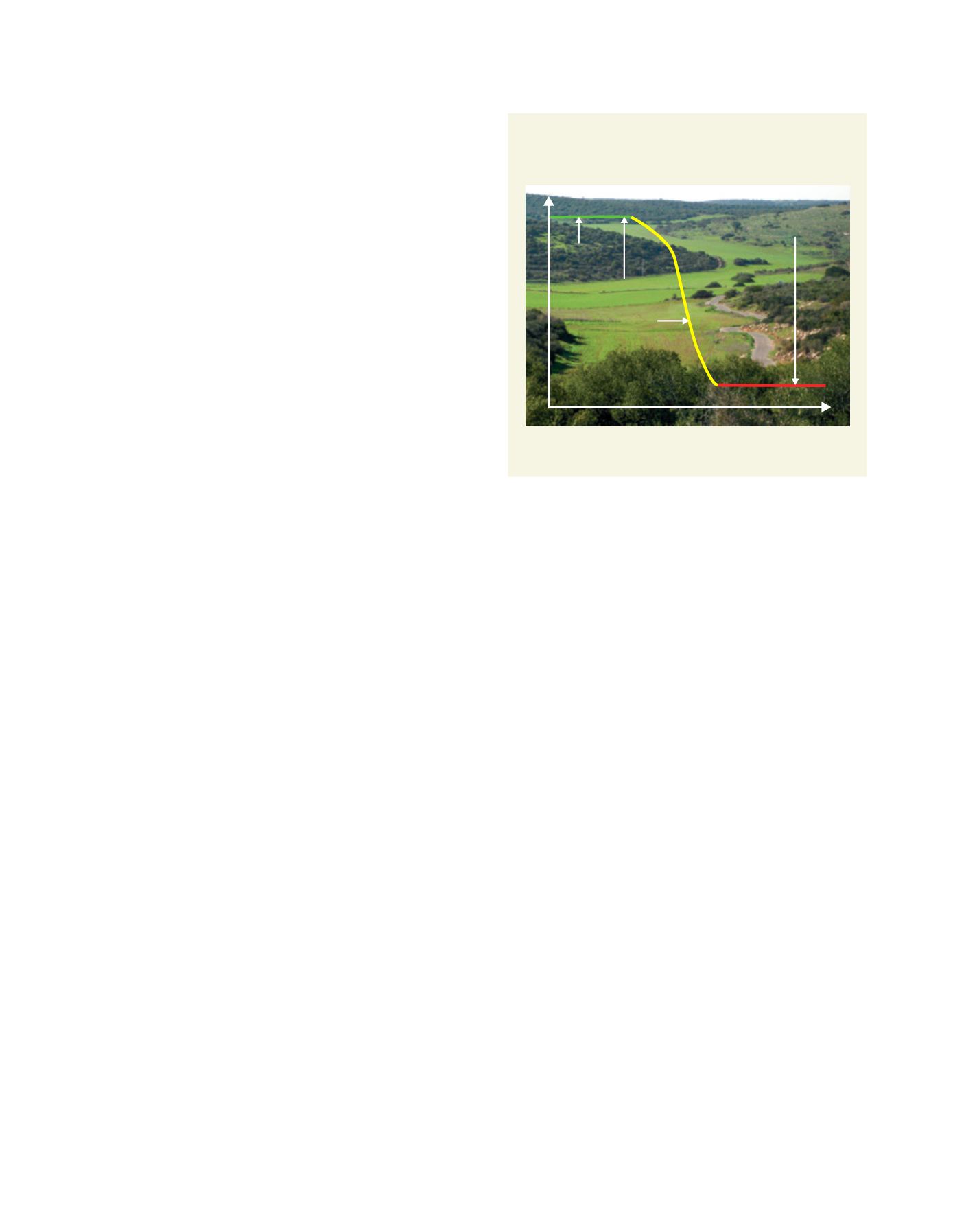

[
] 164
tion’ which, when occurring in drylands, is labelled ‘desertification’.
These are driven by land use practices that turn exploitation into
overexploitation, sustainable into non-sustainable land uses, and
result in reducing rather than increasing land productivity.
Though the knowledge required for sustainable land use
exists through millennia of accumulated traditional knowl-
edge and centuries of scientific research, three interlinked
socioeconomic policy drivers currently combine to invoke the
drivers of land degradation — increasing global human popu-
lation size, increasing per capita calories consumption, and
increasing socioeconomic inequity.
1
These reflect on increas-
ing demands from, and pressure on, soil fertility and point at a
paucity of resources for averting the mounting threats of land
degradation by transporting knowledge and technologies to,
and effectively implementing them in, the developing world.
Though much knowledge for preventing land degradation is
available, means to detect and quantify it are controversial. A
quarter of the global land may be degraded
2
and the socioeco-
nomic and policy drivers of land degradation are intensifying;
hence the rest of the global land is at a risk of land degrada-
tion.
3
Furthermore, local soil erosion, a major driver of the land’s
productivity loss and the loss of vegetation cover, is also the driver
of off-site, transboundary detrimental impacts on non-degraded
lands — covering agricultural plots, blocking water reservoirs,
generating floods and dust storms and increasing water and air
pollution. Other social off-site impacts of local land degradation—
local poverty in degradation-affected areas causingmigrations and
refugees —may trigger foreign interventions.
4
Finally, the spatial
spread of land productivity loss, associated with the impaired soil
function of carbon sequestration, would undermine global food
security and global climate change mitigation, respectively.
Long before land degradation had become widely recognized,
many countries promulgated legislations and adopted policies
each addressing a specific driver of land degradation. In some
cases these increased rather than reduced land degradation,
5
and in most cases they have not explicitly targeted land degrada-
tion.
6
Furthermore, the United Nations Convention to Combat
Desertification (UNCCD) text obliges the parties to more effec-
tively implement and enforce the already existing policies and
states that only when these tools “do not exist”, “enacting new
laws and establishing long term policies” would be required.
7
Thus, in order to address land degradation holistically, land
degradation needs to be recognized as an interlinked syndrome
of global dimensions that requires global policy responses.
The opportunity for this came when the family of nations
under the auspices of the United Nations agreed upon interlinked
development-environment targets—reducing biodiversity losses,
mitigating climate change and alleviating poverty. These cannot
be acheived by setting targets that only address each of these
processes, since the state of soil and its backdrop of biodiversity
loss, climate change and poverty need to be addressed through
setting a land degradation target, ambitious and realistically attain-
able within a plausible time frame. This target, conceived at the
UnitedNations Conference on Sustainable Development (Rio+20),
is the land degradation neutrality (LDN) target.
LDN is based on three observations. First, even though the
precise spatial dimension of degradation is not yet consen-
sual,
8
it is undisputable that degradation already prevails in
many areas.
9
Second, there is sufficient evidence derived from
time-series satellite images that degraded land continuously
accumulates,
10
a phenomenon projected to continue.
11
Third,
degraded soil can be rehabilitated such that land productivity
can be restored, as has been demonstrated by a number of
well-studied cases in non-drylands
12
and drylands.
13
LDN is achieved when, within the time period in which an
amount of non-degraded productive land becomes degraded, an
identical amount of already degraded land of the same productivity
potential is restored to its non-degraded state. In other words, LDN
can be achieved by offsetting the amount of land being degraded
each year through reclaiming land of equivalent area and produc-
tivity potential fromalready degraded land. This implies that when
LDN is achieved, land degradation has not been totally arrested,
but the amount of the domain’s productive land stabilized.
The direct quantifiable indicators of this target are conceptu-
ally (but not yet technically) straightforward: one is the area of
newly-degraded land and the other is the area of degraded land
newly restored, nominally and as proportions of the domain under
consideration. These values need to be compared for determining
the distance from the LDN target set for the LDNproject’s domain.
Thus, attaining the LDN target depends not only on success-
ful restoration, but also on the protection and management for
sustainability of the used land — both the restored land, and the
land not yet degraded but coming under use. Most important is
that attaining LDN is a cumulative process — when each region
within a country achieves LDN, the country as a whole becomes
land degradation neutral; furthermore, all countries combined can
strive to achieve a land degradation neutral world.
An LDN project requires an identification of the state of
land with respect to its productivity, a tool kit for applying
the appropriate land use practices for each state of land, and
a reliable system for monitoring the changes in these states.
These require the support of a global mechanism that assesses
the available science and technology, identifies knowledge
gaps and sets out to bridge them, and then interfaces them
to policymakers, to be eventually extended to the land users.
Identifying states of land use for a local LDN project
in a semi-arid watershed in Israel
Source: Uriel Safriel
Time
Productivity
Sustainable
cropland use
Degraded
rangeland
Degrading
cropland use
Sustainable
rangeland use
L
iving
L
and
















